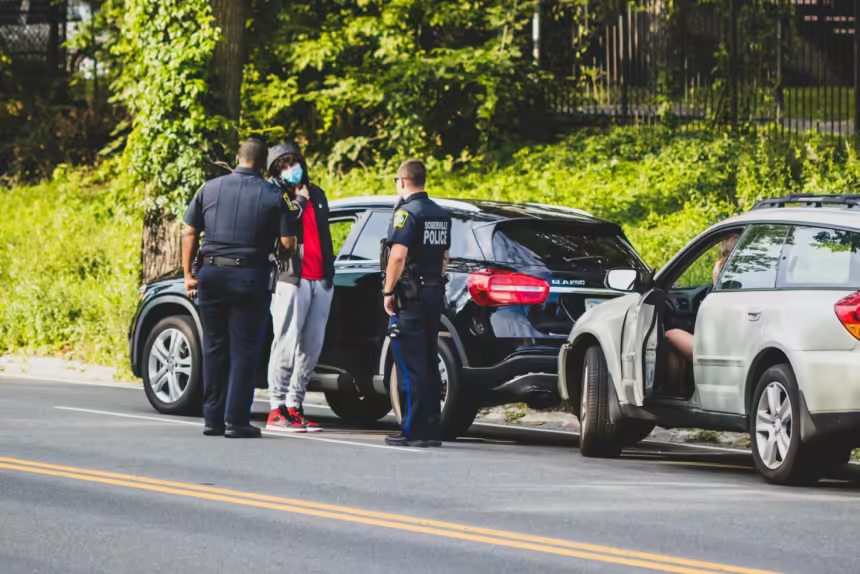In an era where technology permeates every aspect of our lives, its influence on our daily commutes and road safety cannot be overlooked. St. Louis, a vibrant city pulsating with life, is no stranger to the perils of distracted driving.
As smartphones and in-car gadgets become increasingly sophisticated, they also present an unprecedented challenge to drivers’ attention spans. The consequences of this technological interference are dire, manifesting in a disturbing surge of car accidents across St. Louis too. This blog post delves into the intricate relationship between technology and distracted driving in St. Louis.
The aim is to explore the factors that contribute to this growing problem and the potential solutions that can pave the way for safer roads in our beloved city.
The Allure of In-Car Technology
In 2022, around 300,000 people were wounded and 3,000 died in motor vehicle traffic collisions caused by distracted drivers in the United States.
In-car technology has become increasingly prevalent in St. Louis vehicles. These advancements aim to enhance the driving experience in the city. However, they also introduce new distractions that can jeopardize road safety on busy thoroughfares like I-64 and I-270.
Infotainment Systems
Touchscreens provide access to a wide array of features and functions, but they demand your quick attention. If you take your eyes off the road, even for a second, it puts you and other cars on the road in danger.
Moreover, navigation systems are also a big source of distraction. With your attention on the maps for the next sharp turn to the Delmar Loop, you might miss important traffic cues on the road.
And do you like your music loud when stepping on the gas, cruising down Washington Avenue? You are bound to be more hooked on the audio controls on the system in front of you than on the road.
Remember that if you randomly decide to slow down your vehicle to scan through your playlist, you risk a rear-end collision. Also, adjusting audio settings or browsing through playlists can divert attention from driving on congested highways like I-44.
The cognitive demands of engaging with in-car technology can reduce situational awareness for St. Louis drivers, increasing the risk of accidents on the city’s roads.
Voice-activated Features
Siri, Google Assistant, and Amazon Alexa have soared in popularity among drivers all over the world. These virtual assistants enable motorists to perform tasks hands-free while navigating the city’s streets.
Users can make calls, send texts, and access information without taking their eyes off the road during rush hour on I-170. Although these features are meant to reduce physical distractions, they still require cognitive attention from St. Louis drivers.
Engaging with voice-activated systems can lead to mental distractions and slower reaction times, especially in congested areas like the Poplar Street Bridge.
How Distractions Cause Accidents
Distracted driving isn’t a minor inconvenience on St. Louis’s bustling roads; it’s a recipe for disaster. Imagine inching along I-64 at 55 mph and you take your eyes off for a mere 5 seconds fidgeting with your audio player. This is like covering the length of a football field with your eyes closed!
In no time your car slams into the back of the one ahead. This scenario, tragically common, highlights the dangers of a divided mind behind the wheel.
Our brains are like single-lane highways—they can only handle a limited amount of traffic at once. When distracted by phones or in-car entertainment systems, critical cognitive resources are diverted, impacting St. Louis drivers in three crucial ways:
Reaction Time Blues: Studies show distracted drivers have significantly slower reaction times. This can be the difference between avoiding a fender bender and causing a multi-car pileup on the already congested I-70.
Situational Awareness Fading: Distractions create a tunnel vision effect, limiting a driver’s ability to scan for hazards. Imagine missing a merging car on the busy Daniel Boone Expressway because you’re glancing at your phone.
Decision-Making on Mute: The ability to make quick and sound judgments is compromised when your focus is elsewhere. Spotting a pedestrian crossing against the light at a busy downtown intersection requires immediate action, something a distracted driver might miss.
Just last month, two pedestrians lost their lives in separate accidents in the St. Louis area. A man died in a South City hit-and-run, while a 64-year-old was killed hours later while walking in St. Charles.
Common Types of Accidents
Distracted driving triggers a chain reaction of potential accidents on St. Louis’s diverse roadways:
Rear-End Collisions: The most common consequence. With delayed reactions to braking lights, drivers plow into the car ahead, especially during rush hour commutes on narrow city streets.
Head-On Crashes on the Highway: Swerving due to distractions can lead to devastating head-on crashes on high-speed highways like I-270.
Lane Departures on Local Roads: Weaving out of lanes or drifting off course becomes more likely when a driver’s attention is pulled away from the road, making winding streets like those in Lafayette Square even more dangerous.
Pedestrian and Cyclist Threats: Distracted drivers pose a significant threat to vulnerable road users, like pedestrians navigating busy sidewalks or cyclists sharing the road on Cherokee Street.
If you or anyone you know has met with a car accident due to the negligence of the other driver, you can file a personal injury lawsuit against them. Talk to a St. Louis car accident attorney about your legal recourse. These expert professionals have a deep understanding of the local state laws and will also shield you from money-hungry insurers.
According to TorHoerman Law, you need concrete evidence to support your injury claims. Take pictures of the collision, note down the license plates of all the automobiles involved, and record the driver’s licenses and other pertinent accident information.
These things might seem like a lot after a gruesome car accident, but a competent lawyer will help you every step of the way.
Siddens Bening Hands-Free Law
Missouri finally joined 48 other U.S. states in enhancing road safety by passing the Siddens Bening Hands-Free Law in 2023. This legislation aims to minimize distractions caused by cell phone use while driving.
Moreover, the law prohibits behaviors such as texting, browsing the internet, watching videos, and making hand-held calls. However, it allows hands-free or voice-operated interactions and the use of devices when lawfully stopped or parked. Limited exceptions include reporting emergencies, navigation, and listening to podcasts.
The law strikes a balance between safety and practicality, acknowledging the realities of modern life. By aligning with the majority of the U.S. in combating distracted driving, Missouri has taken a significant step toward reducing accidents and saving lives.
To conclude, the fight against distracted driving requires a multi-pronged approach. Legislation like the Hands-Free Law is a crucial first step, but public education campaigns can further raise awareness about the dangers of in-car technology.
Additionally, car manufacturers themselves can play a role by designing interfaces that minimize distraction and prioritize safety. Ultimately, the collective effort of lawmakers, educators, and technology developers can pave the way for a future where St. Louis roads are safer for drivers, pedestrians, and cyclists alike.






